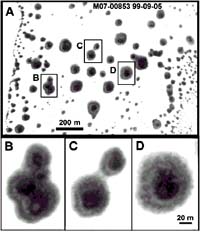
Scientists at NASA contend it's an interesting photo of ice melting, who knows? We could spend billions sending a fleet of probes or billions sending humans to solve the mystery. It's a fascinating place.
Posted on 04/05/2002 11:04:40 AM PST by GeneD
Scientists have found "intriguing" new evidence that may indicate there is life on Mars.
An analysis of data obtained by the Pathfinder mission to the Red Planet in 1997 suggests there could be chlorophyll - the molecule used by plants and other organisms on Earth to extract energy from sunlight - in the soil close to the landing site.
Researchers stress their work is in a very preliminary state and they are far from making definite claims.
Even so, the work is attracting much attention in the scientific community and will come under intense scrutiny when it is presented to an astrobiology conference in the US next week.
Dr Carol Stoker, from the American space agency's (Nasa) Ames Research Center, confirmed the findings to BBC News Online but cautioned that they were "not ready for the big time".
Early data
Mars Pathfinder mission touched down in the Ares Vallis region of Mars in July 1997. It took many images of the surrounding area and released a small rover to sample rocks.
A detailed analysis of the images of the landing site now reveals two areas close to Pathfinder that have the spectral signature of chlorophyll.
According to experts it might be highly significant - or could be just a patch of coloured soil.
Dr Stoker's team scrutinised the so-called Superpan, which is a high-resolution, highly processed series of superimposed images produced by Pathfinder's camera.
It is a multispectral panorama of the landing site recorded in 15 regions of the spectrum, and contains a wealth of information about rock types, colours and textures.
Knowing the spectral signature of chlorophyll, the researchers wrote a computer program that systematically scanned the Superpan for any pixels of interest.
Specifically, the program looked for the spectral signature associated with red light absorption by chlorophyll.
Previous searches for evidence of chlorophyll in Pathfinder's pictures were carried out shortly after it landed.
Some tentative indications were seen but they were later dismissed as "possible image misregistration".
Two patches
In Dr Stoker's study six regions of the Superpan matched positive for the chlorophyll signature.
For each of the regions, a full spectrum was plotted out and their exact position in the Superpan was then carefully examined.
All of the detections occurred close to the camera. This is to be expected say the researchers, as these are the areas where the camera has the highest sensitivity and resolution.
Close examination revealed that four of the cases occurred on the Pathfinder spacecraft itself. But two regions showed a chlorophyll signature in the soil around Pathfinder.
Given the controversial nature of their findings and the early stage of the research, the scientists want to hold back any claims about what they may have found until they have done more work and prepared a detailed paper for submission in a scientific journal.
Why? Do you think so?

Scientists at NASA contend it's an interesting photo of ice melting, who knows? We could spend billions sending a fleet of probes or billions sending humans to solve the mystery. It's a fascinating place.
Atlantis ?
When our daughter was 4, it was a giant squash. She saw it on the Dinasours Show (with Earl, Robbie..etc.) and couldn't shake it. The squash was too scary!
Would it be worth the trouble to go to Mars for salad garnish?
Save your money and hang out with me. I throw the stuff away, and you can have all you want.
What do you think the odds are that cholorophyl evolved on Mars first, given that Earth has been much more hospitable to life for over 3 billion years?
What do you think the odds are of cholorophyl evolving independently on two neighboring planets?
We know their are Martian meteorites on the Earth, so it stands to reason that there are Earthian meteorites on Mars.
The odds that blue-green Earthian cyanobacteria could survive the trip are better than the odds for Mars-first or independent cholorphyl evolution.
So: If there is cholorophyl on Mars, it got there from Earth.
Weird!
When I was 40 I had a nightmare that I was goosed. I think all these events are related. Miss Cleo thinks so too.
The real question is, "Is there life at the BBC?"
Thanks, there's already enough green things growing in my kitchen. Other colors, too. Now, if they discover beef cattle on Mars, that's a different story.
By "that green blood that some sea creatures have," are you talking about the copper-based blood of cephalopods? Interesting about that... copper-based blood isn't as efficient as iron-based for transporting oxygen and carbon dioxide. So the really smart mollusks, like squids, octipi, and cuttlefish are just about tapped out as far as evolving higher intelligence. Their blood can't support the type of brain needed, because they're all on the brink of oxygen deprivation anyway.
That's one reason so many aquarists fail at keeping cephalopods.. insufficient dissolved oxyegen in the water. Temperature is onther hurdle.
Anyway, your scenario for some sort of parallel evolution of chlorophyl (or something like it) on Mars isn't impossible, but not bloody likely, IMHO.
I think an Earthian contamination scenario is far more compelling.
Another boarder to watch.... more illegal aligns
Disclaimer: Opinions posted on Free Republic are those of the individual posters and do not necessarily represent the opinion of Free Republic or its management. All materials posted herein are protected by copyright law and the exemption for fair use of copyrighted works.